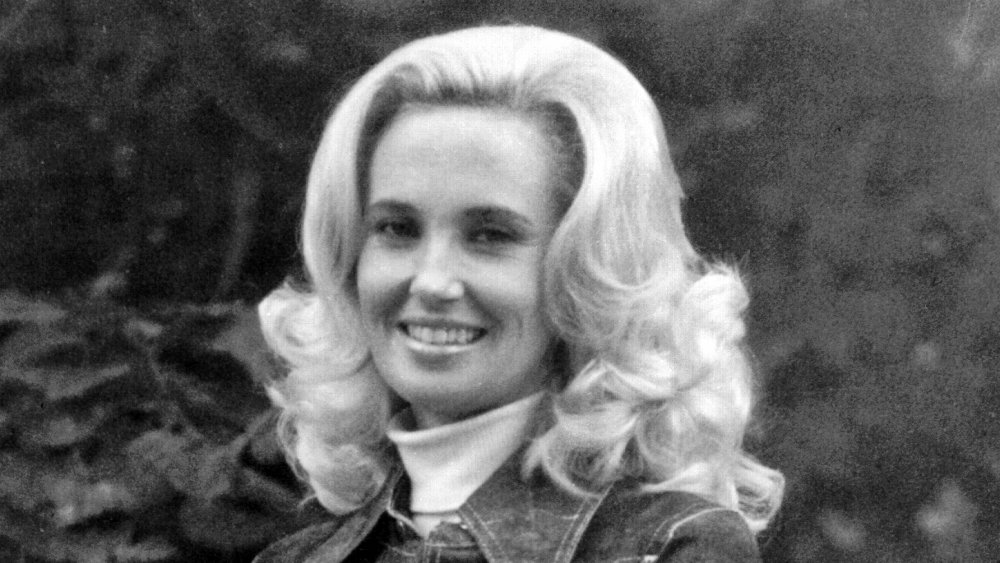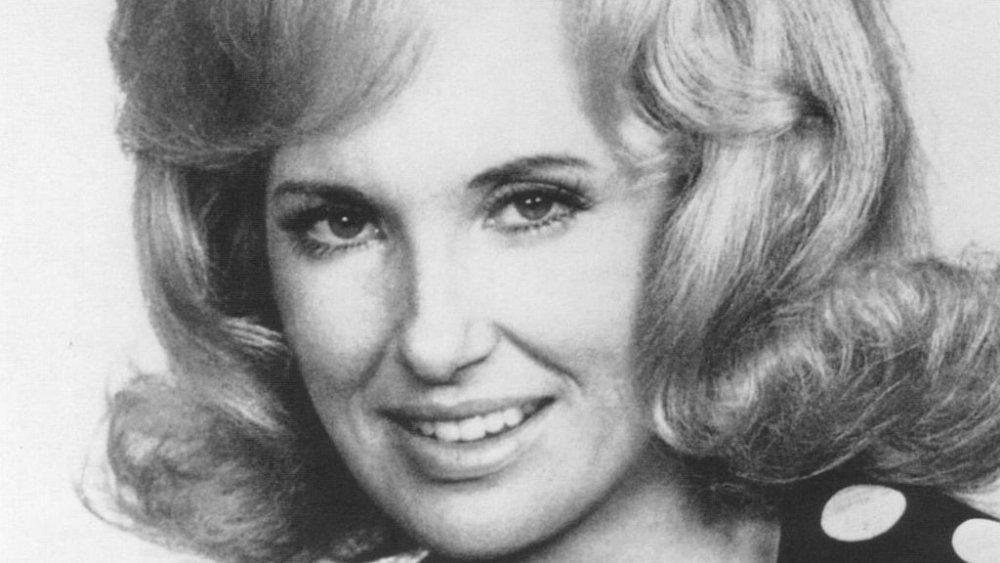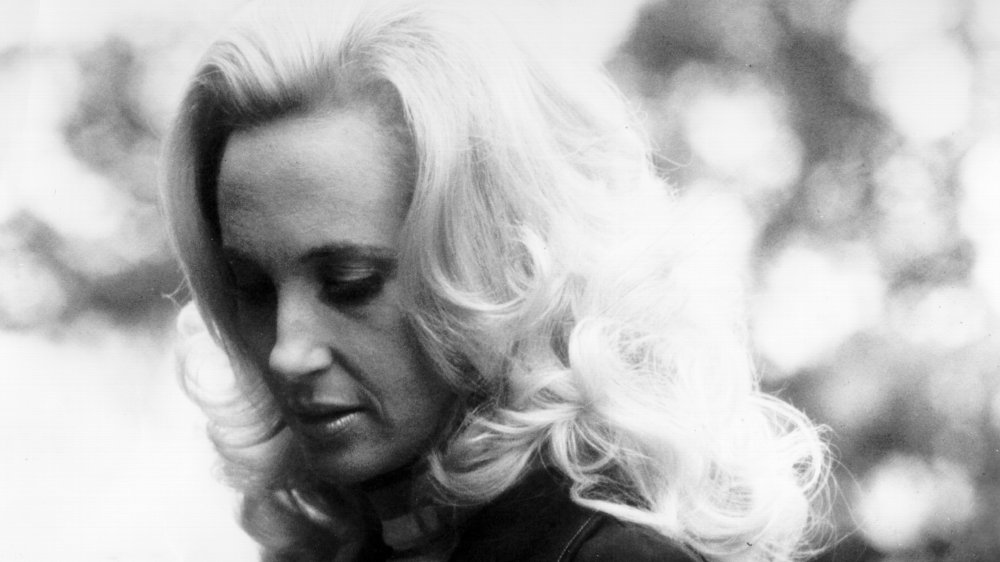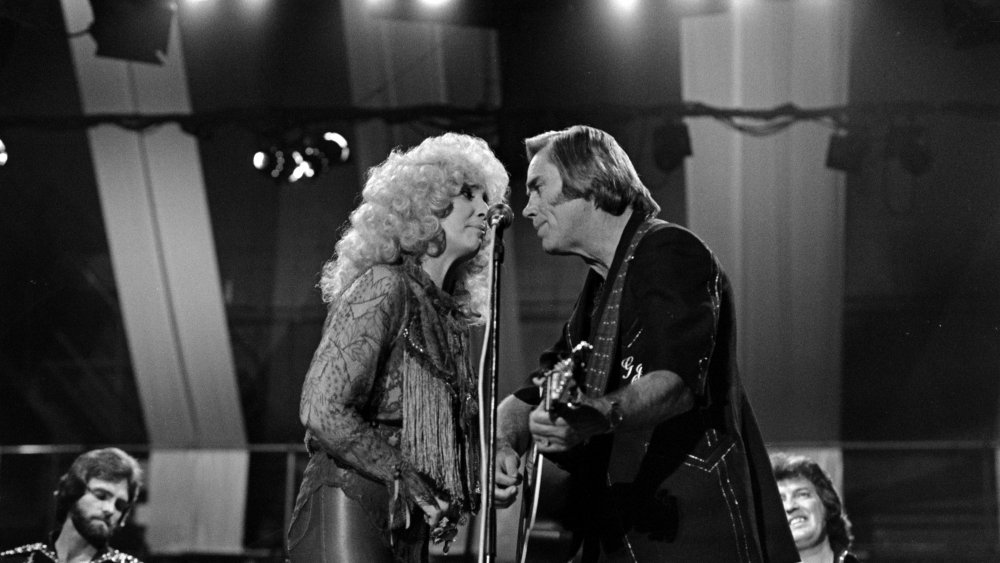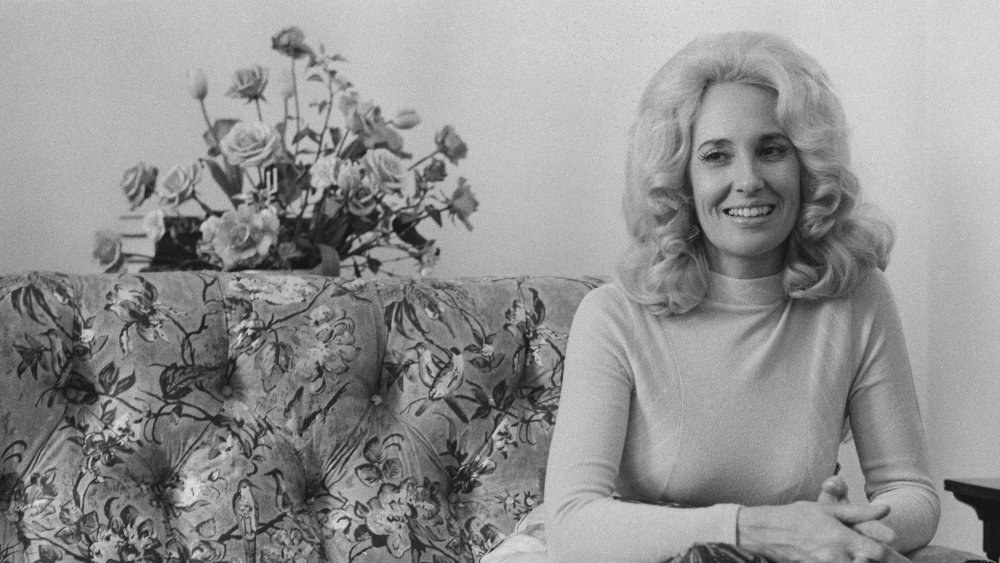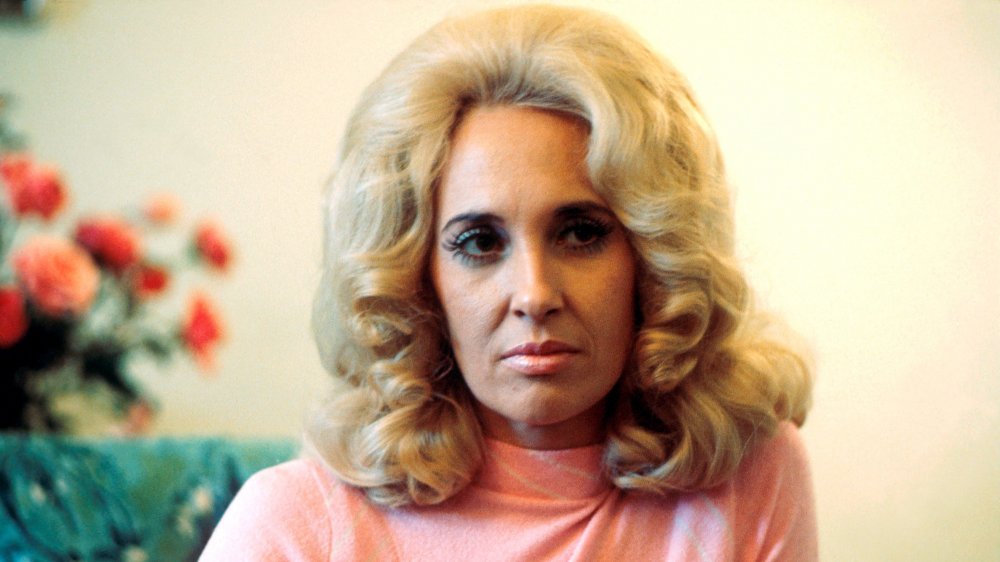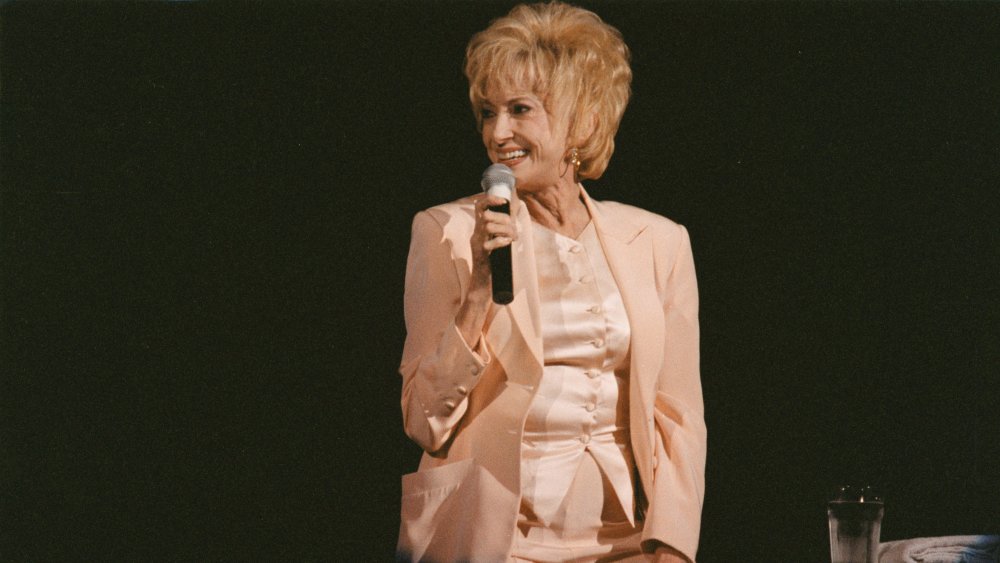The Tragic Real-Life Story Of Tammy Wynette
Tammy Wynette's life was like a country song. She really lived every trope: enduring a tough rural childhood, working as a beautician and dreaming of a better way, finding and losing love, rising to fame and fortune only to die too young.
But Wynette's determined, loud presence in country music history set her apart from the clichés. She didn't have the looks or style of other country superstars. In an excerpt from his book Tammy Wynette: Tragic Country Queen, Jimmy McDonough noted that "unimaginative types who don't savor esoteric looks might be dim-witted enough to consider her a tad homely" and described her first appearance at the 1968 Country Music Awards thusly: "Only twenty-six, Tammy already seems a bit shopworn. The mountain of makeup can't completely hide the worry, the fear, the dark circles lurking below tired eyes." Her gift was her "atom-bomb voice" that imbued her songs "with such feeling that anybody with half a heart would have to acknowledge the sheer conviction on display, the utter reality of her pain."
It was what the country music world had been waiting for; Tammy Wynette sold a total of 30 million records over the course of her career, earning her designation as The First Lady of Country Music.
Wynette's humble beginnings on a Mississippi cotton farm
Tammy Wynette was born Virginia Wynette Pugh on her family's cotton farm in Itawamba County, Mississippi in 1942, per AllMusic. Her father died of a brain tumor when she was less than a year old and her mother moved to Birmingham, Alabama to find work, leaving Pugh in the care of her grandparents. By the age of seven she was working alongside her family picking cotton, a story she would later honor by "keep[ing] a crystal bowl full of cotton in her home to remind her of these meager beginnings," according to her official website. Her father had been an amateur musician who played piano and guitar; she taught herself to play the instruments he had left behind, dreaming of escaping the constant, backbreaking toil of working on a farm.
She married her first husband, Euple Byrd, at the age of 17 and had her first two children, Gwendolyn and Jacqueline, within three years. Living conditions were "even harder than she'd known at home," with her husband often unemployed and their home an "abandoned log house with no indoor plumbing." According to People magazine, Wynette said the stress caused her to have an emotional breakdown, which was treated with electroshock therapy. Later discussing the treatments, Tammy Wynette said: "they were horrible, but they helped me."
Wynette was considered lousy by her peers
In her late teens, Tammy Wynette's mother paid for her to go to beauty school and she became a licensed beautician. People magazine reported that she told her skeptical classmates her dream of becoming a country music singer; one later remembered, "She was lousy then. Real twangy. I never in a million years thought that girl would amount to anything." Even after Wynette reached superstardom, she kept her beautician's license up to date for the rest of her life, never taking her singing career for granted and figuring "she could always go back to hairdressing."
After earning her beautician's license, Wynette left her husband and moved to Birmingham, Alabama, where she gave birth to her third daughter, Tina. Born prematurely and soon enduring a bout with spinal meningitis, the baby almost didn't survive. Wynette's marriage was officially dissolving and she was working ten-hour days as a beautician after getting up at four o'clock in the morning to sing on the local television program The Country Boy Eddie Show for $30 a week. Unlike her beauty school classmate, host Eddie Burns was impressed with Wynette's singing, and per People, he told Wynette, "The way you sing, you ought to go to Nashville." According to her website, she had been to Nashville to meet with producers but hadn't had luck getting signed. Nevertheless, in 1966, after a string of rejections, she moved to Nashville anyway with "no job, no place to live, and three small children totally dependent on her."
Becoming Tammy Wynette
Tammy Wynette's luck changed when she auditioned for producer Billy Sherrill at Epic Records who liked her voice. Sherrill claimed, per People, that when he listened to her, "a little teardrop every now and then appears." He signed her and suggested she rename herself "Tammy," as she resembled the character played by Debbie Reynolds in the movie Tammy. In 1966, she recorded her first single, a cover of the Bobby Austin hit "Apartment #9." Right from the start, Wynette used her teardrop-tinged voice to sing songs of heartbreak and loneliness; "Apartment #9" starts with the lyric, "Just follow the stairway, to this lonely world of mine" and only gets sadder from there. It peaked at No. 44 on the Billboard Country chart in January of 1967.
Her first album, Your Good Girl's Gonna Go Bad, was released in May 1967; it was a hit, with the title track reaching No. 3 on the Billboard charts. By the end of 1967, Wynette had two No. 1 country singles, "My Elusive Dreams," a duet with David Houston, and her first solo No. 1 song "I Don't Wanna Play House." It was another tear-jerker, this one sung from the point of view of a woman overhearing her little girl tell a playmate "I don't want to play house/It makes my mommy cry/'Cause when she played house/My daddy said good-bye." Singing sad songs was working well for Wynette; her first No. 1 song also earned her a Grammy for Best Female Country & Western Solo Performance.
Wynette's Stand By Your Man created controversy
A year later, Wynette recorded the song that would become not only as her signature song but one of the most famous songs in all of country music. Wynette and Billy Sherrill co-wrote "Stand By Your Man" in just fifteen minutes and released it in 1968, according to SmoothRadio.com. It was another No. 1 hit on the Billboard Country Singles chart and crossed over onto the Pop chart as well, peaking at No. 19. It also earned her a second and final Grammy, although she would be nominated 12 more times.
The song was controversial from its beginnings and this was no accident on the part of Wynette's record label. Per Garden & Gun, Epic released an ad to market the single reading "Tammy Wynette's answer to women's lib: Stand By Your Man." According to NPR, Newsweek responded by calling it "for the beleaguered housewife who grits her teeth as destiny dumps its slop on her head." NPR spoke to Wynette's friend and publicist Evelyn Shriver about the song, who said the singer never got tired of singing the classic but did get tired of defending it. Wynette reportedly said, "It's unbelievable to me that a song that took me 20 minutes to write, I've spent 20 or 30 years defending." The controversy continued right up to 1992 when then-aspiring First Lady Hillary Clinton, addressing the latest rumors about her husband's philandering, famously quipped, "I'm not sitting here some little woman standing by my man like Tammy Wynette."
Tammy Wynette and George Jones became Mr. and Mrs. Country Music
Ironically, during the "Stand By Your Man" era, Tammy divorced her second husband, Don Chapel, and in 1969 married her third husband, country music star George Jones. The two met in a Nashville recording studio, and per Biography, got together after Jones declared his love for Wynette while she was fighting with her second husband. They became an iconic country music couple, toured together as "Mr. and Mrs. Country Music," had a daughter, country singer Tamala Georgette Jones, and recorded several chart-topping albums and duets together such as "We're Gonna Hold On" and "The Ceremony," in which they put their own wedding vows to music.
Their marriage was stormy from start to finish, in part because of Jones's addictions to alcohol and cocaine. Wynette once described their dynamic as "I was naggin' and he was nippin'," and claimed he once chased her with a rifle. Despite divorcing after just six years, they continued working together regularly through 1980 and even made a reunion album and toured together in 1995. At one show, according to People, Jones introduced his ex-wife by announcing, "I'm gonna bring out Miss Tammy Wynette now and see if we can get along for the first time in our lives." George Jones explained that singing together "brings back a lot of memories of old stage things when we used to work together. But as far as bringing back old memories of other things, it don't. We've completely blocked all that out of our minds."
The Golden Age of Tammy Wynette
The 1970s were Tammy Wynette's golden age; throughout her career, she had 20 No. 1 hits and 39 top 10 Billboard Country hits. The majority of these charted during the '70s, including "'Til I Can Make It On My Own," which she claimed was her favorite of her own songs. The song served as the title track of her first album recorded after her divorce from George Jones. With lyrics like, "'Til I get used to losing you/Let me keep on using you/'Til I can make it on my own," it's likely Wynette was using the public's interest in her relationship with Jones and her propensity for singing songs of lost love and heartache to keep people listening and buying her records. It worked.
Her personal life remained dramatic. After her divorce from Jones, Wynette briefly dated fellow '70s icon Burt Reynolds and married Nashville real estate tycoon Michael Tomlin — the marriage lasted just 44 days. In 1978, Wynette married her fifth and final husband, George Richey, who worked as her manager for the rest of her career and with whom she co-wrote several songs, including, ironically, "'Til I Can Make It On My Own." People quoted her as saying about Richey, "I made a lot of mistakes, but thank God I finally got it right."
Was Wynette abducted at gunpoint from a mall?
Of course, tragedy always seemed to chase Tammy Wynette and by the mid-1970s, she was dealing with more than her fair share of bad times. On a Fox Radio podcast in 2017, daughter Georgette Jones described two separate 1976 incidents, one in which "somebody had broken in [to their home] and they had turned on every faucet, every sink, every bathtub, every shower in the entire house so the house was flooded." There was another incident in which Jones was sleeping in her mother's bedroom and "that part of the house caught on fire and the entire back portion of the house, we had to close off... it was completely burned. Burned away."
An even more horrifying and bizarre incident took place in 1978. In a story about country music's ten wildest stories, Rolling Stone reported that Wynette was "allegedly abducted at gunpoint from a Nashville mall parking lot, claiming the masked gunman had beaten then abandoned her on a country road 80 miles south of town." Wynette gave interviews describing her ordeal in which she had visible bruises on her face and a fractured cheekbone; the identity of her kidnappers remained a mystery. Later, Wynette's daughter Jackie Daly wrote in her memoir that "Wynette had confessed to her the kidnapping was faked to cover up a beating that her fifth husband, George Richey, had inflicted," according to Rolling Stone. Richey vehemently denied the allegations; it would not be the last time he would face accusations from his stepdaughters regarding their mother.
Wynette faced a lifetime of heath problems
Tammy Wynette had serious health problems throughout most of her adult life. As Villages News reported, a hysterectomy after the birth of her fourth daughter left her with an infection that caused painful scarring and permanent intestinal symptoms. Around the same time, Wynette developed an obstruction in her bile ducts that damaged her gallbladder and caused further abdominal pain. She also endured multiple surgeries including on her kidneys and her vocal cords when she developed nodules that needed removal. According to Villages News, Wynette often couldn't perform without first taking painkillers to manage the amount of pain her body endured and at times relied on backup singers to sing her parts.
In 1986, she entered the Betty Ford Center to treat her addiction to painkillers, later telling People magazine, "I never took cocaine or marijuana or even speed. I just needed something to ease pain, and stupidly I just flat overdid it." In 1995, a near-fatal liver ailment sent her to the hospital again, about which she said, "I was just that far from being dead. I had no pain. I wasn't scared. It was all just very peaceful. I felt like I was floating somewhere." Ironically, this painful experience caused some healing in her personal life. After not speaking for several years, George Jones visited his ex-wife in the hospital and they resumed a friendship as well as a working relationship. Their aforementioned reunion album One and national tour was the result.
Standing by the JAMs
In 1992, Tammy Wynette made an unexpected return to the Billboard Hot 100 by providing vocals for the song "Justified and Ancient (Stand By The JAMs)" by British electronic duo The KLF (pictured above). The KLF are notorious for such antics as announcing their departure from the music business in 1992 via a performance at the Brit Awards during which they fired machine gun blanks into the audience and left a dead sheep on the steps of the hotel hosting an aftershow party. They later burned the bulk of their earnings from record sales, a million pounds in cash.
According to Dangerous Minds, band member Jimmy Cauty "randomly" suggested using Wynette on a song, and his partner Bill Drummond, a fan of Wynette and country music in general, agreed. He flew to Tennessee to meet with Tammy and ask her to collaborate. Drummond later called the project "an evil and corrupt exchange ... the young artist wanting to tap into the mythical status and credibility of the has-been, the has-been wanting some of that 'I'm still contemporary, relevant, will do anything to get back into the charts' stuff." Nevertheless, Wynette called the experience "the most rewarding thing I've ever done outside of country music" and fondly recounted making the music video for Entertainment Weekly: "I was perched 50 feet in the air dressed as a queen, with a bunch of Zulu dancers around me, Japanese girls with long blond wigs, and of course Bill and Jimmy."
Tammy Wynette had a tough life
Tammy Wynette's health problems caught up with her one last time. Rolling Stone reported that the First Lady of Country passed away in her sleep at home on April 6, 1998; she was 55 years old. The cause of death was presumed to be a blot clot in her lung. She worked right up until the end of her life; according to FoundAGrave.com, her final concert appearance took place on March 5, 1998, when she filled in for ill fellow country music legend Loretta Lynn and her final television appearance was four days later on the Nashville Network's Prime Time Country. Publicist and friend Evelyn Shriver told People magazine, "She deserved an easy death. She had a tough life."
Controversy followed Tammy Wynette even after she was no longer around to endure it. Per Country Living, Wynette's daughter Georgette Jones blamed her stepfather George Richey for her mother's untimely death, stating that he "tried very hard to separate mom from her family and friends so he could be the only person she could turn to. I think she felt like she had no choice and it was too difficult to fight" and opined that by encouraging Wynette to overuse painkillers, he was indirectly responsible for her demise. Three of Wynette's daughters filed a $50 million wrongful death lawsuit against Richey. According to CMT News, her body was exhumed and examined, with the results confirming Wynette had died of natural causes (heart failure). Tammy Wynette's daughters dropped the lawsuit in 1999.
